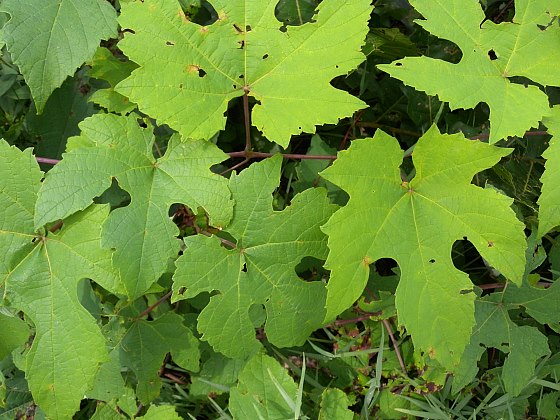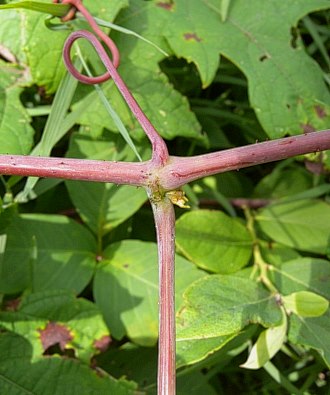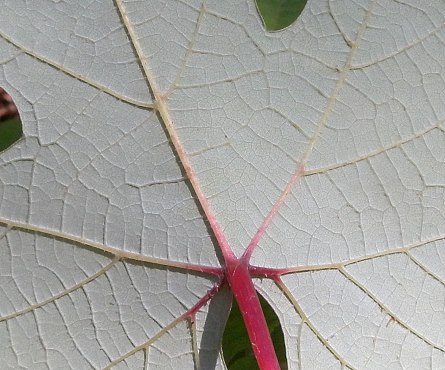
The greenish yellow flowers are produced in panicles about 2-5" long. These flowers can be either unisexual (male or female) or perfect. Individual flowers are about 1/8" (3 mm.) across, consisting of 5 deciduous petals, an insignificant calyx that has been reduced to a flat disk, and the reproductive organs. Male flowers have 5 prominent stamens, while female flowers have a superior ovary with a short style. Perfect flowers have both types of reproductive organs. The blooming period occurs from late spring to early summer and lasts about 1 week. The flowers are quite fragrant. Fertile female flowers are replaced by berries that are arranged in panicles about 3-8" long. These panicles are usually wider near their bases than toward their tips. After they become mature during late summer or autumn, individual berries are ¼-½" across, globoid in shape, dark blue to black, and slightly glaucous. Each berry has a juicy interior with 1-4 small seeds. The flavor of mature berries varies from sweet to sour.
Cultivation: This woody vine prefers full to partial sun, mesic to dry-mesic conditions, and soil containing sandy loam or some rocky material. Production of berries is facilitated by exposure to sunlight.
Range & Habitat: The native Silverleaf Grape is occasional in NE Illinois, otherwise it is rare or absent. This map combines the distribution of the more common typical variety, Vitis aestivalis aestivalis (Summer Grape), and Vitis aestivalis bicolor (Silverleaf Grape), as described here. Habitats for Silverleaf Grape include upland sandy woodlands, rocky open woodlands, sandy savannas, openings in sandy woodlands, woodland borders, sandy thickets, areas along woodland paths, slopes of sandy bluffs, and roadsides. In these habitats, oak trees (especially Black Oak) are the dominant canopy trees. Silverleaf Grape is more common in areas where there has been occasional wildfires and other kinds of disturbance.
Faunal Associations: The flowers are cross-pollinated by bumblebees, honey bees, long-horned bees (Eucera spp.), and probably other bees. These bees collect pollen and possibly nectar to feed their larvae (Robertson, 1929). Other insects feed destructively on the leaves, sap, wood, and other parts of Silverleaf Grape and other wild grapes (Vitis spp.). This latter group of insects includes the larvae of long-horned beetles, leaf beetles, weevils, Scarab beetles (including Japanese Beetles), aphids, spittlebugs, leafhoppers, armored scales, treehoppers, Grape Phylloxera (Daktulasphaira vitifoliae), mealybugs, Giant Walkingstick (Megaphasma denticrus), thrips, and the larvae of several kinds of moths, including: Geometer moths, leaf blotch miner moths (Gracillariidae), shield-bearer moths (Heliozelidae), owlet moths (Noctuidae), Sphinx moths, and window-winged moths (Thyrididae). The Insect Table provides a more complete list of these insects. The abundant insects that these vines attract provide food to many kinds of insectivorous birds. Some birds also feed on the fruits of Silverleaf Grape Vine and other wild grapes. This includes tanagers, crows, sparrows, blackbirds, orioles, woodpeckers, thrushes, vireos, some warblers, and upland gamebirds. See the Bird Table for more information about these species. Many birds species also use these woody vines for protective cover and nesting habitat. Thin strips of bark from old vines are also used in the construction of nests by some birds.

Silverleaf Grape and other wild grapes are also valuable to various mammals. Like birds, many mammals feed on the fruit of these woody vines, including the American Black Bear, Gray Fox, American Red Fox, Virginia Opossum, Raccoon, Striped Skunk, Prairie Spotted Skunk, and Fox Squirrel. Domestic goats and White-tailed Deer also feed on their leaves, tender shoots, and/or branches (Beeman & Pelton, 1980; Martin et al., 1951/1961; Blackmore, 1998; Sokala & Kirkpatrick, 1973). Both birds and mammals spread the seeds of the fruits far and wide. In addition, when grape vines sprawl across the ground, the fruits are sometimes eaten by the Eastern Box Turtle (Ernst et al., 1994).
Photographic Location: A sandy savanna at Indiana Dunes State Park in NW Indiana.

Comments: Silverleaf Grape is the only native wild grape in Illinois with leaf undersides that are bright white, hairless, and glaucous. The more common typical variety, Vitis aestivalis aestivalis (Summer Grape), has leaf undersides with appressed woolly hairs. In form, the leaves of Silverleaf Grape resemble those of Vitis palmata (Catbird Grape), which is restricted to southern Illinois. Catbird Grape, however, has leaf undersides that are light green and glabrous; they are never bright white and glaucous. Another native species, Vitis cinerea (Winter Grape), often has leaves with bright white undersides. However, this is the result of fine woolly hairs that are bright white. Unlike Silverleaf Grape, Winter Grape never has deeply lobed leaves. Another scientific name of Silverleaf Grape, Vitis aestivalis argentifolia, is sometimes used, but it is a junior synonym. Silverleaf Grape was originally regarded as a distinct species, Vitis bicolor.